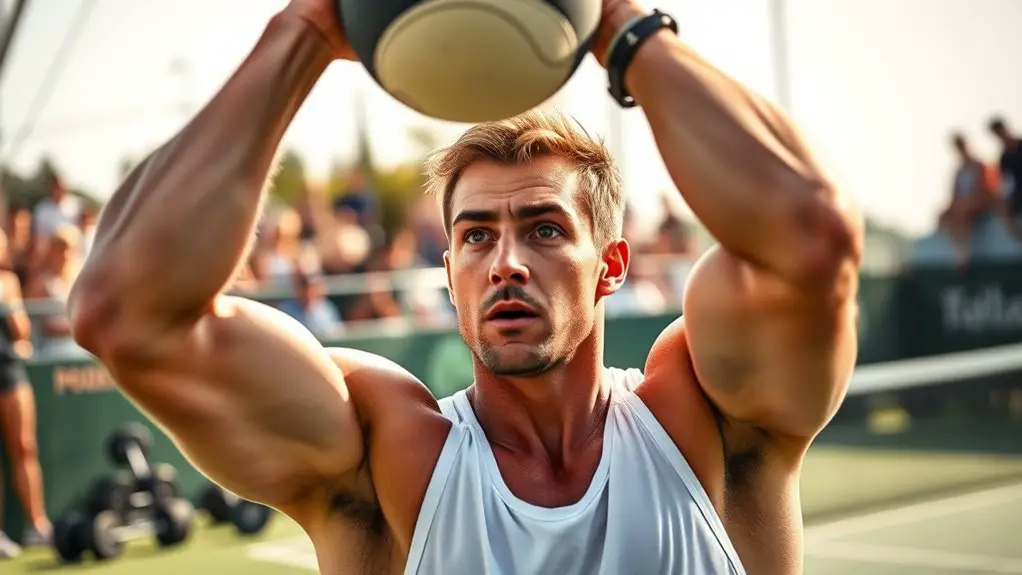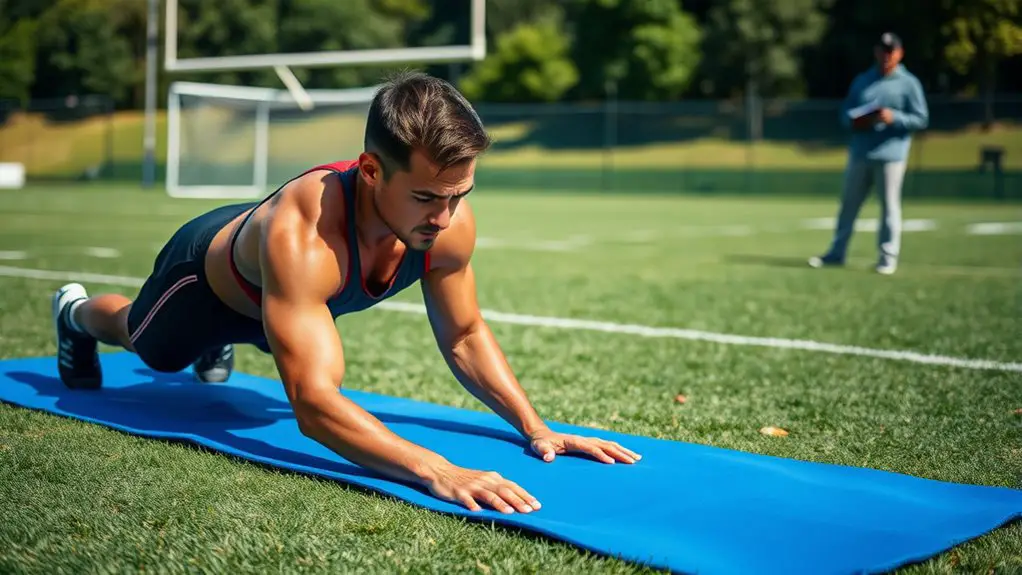To increase your batting power through weight training, focus on exercises that build strength in key muscle groups. Target your core for stability, upper body for swing strength, and lower body for balance. Incorporate kettlebell swings, squats, and lunges into your routine. It's crucial to maintain proper technique to prevent injuries. A balanced regimen will improve your performance and guarantee continual progress. Discover more about effective training strategies and injury prevention next!
Understanding the Importance of Strength Training for Batting Power
When you realize that strength training is essential for enhancing your batting power, you'll see how it can transform your performance on the field. The strength training benefits are immense, offering you the chance to not just hit harder but also gain better control and consistency in your swings. By committing to a structured routine, you'll foster significant muscle growth impact, which directly contributes to the explosive force you need when you step up to the plate.
Imagine feeling that surge of power as you make contact with the ball, sending it flying into the outfield. Strength training isn't just about lifting weights; it's about releasing your potential and achieving that freedom to express yourself through your game. With the right approach, you'll build the strength to dominate, leaving your competitors in the dust. Embrace this journey, and watch your batting power soar. Additionally, developing key physical attributes through targeted exercises will further enhance your overall performance.
Key Muscle Groups to Target for Enhanced Swing Performance
To maximize your batting power, focusing on key muscle groups is essential. You'll want to enhance your core strength for stability, boost upper body power for a stronger swing, and develop lower body stability for better balance. Targeting these areas will greatly improve your overall swing performance. Incorporating squats into your training routine can also significantly enhance your lower body strength, further contributing to your batting power.
Core Strength Development
Core strength is essential for maximizing your batting power, as it serves as the foundation for a powerful swing. By focusing on core engagement and developing your rotational strength, you'll enhance your ability to generate force and control during your swing. Here are key muscle groups to target:
- Abdominals: Strengthen your core stability and balance.
- Obliques: Improve rotational power for more explosive swings.
- Lower Back: Support overall core strength and prevent injury.
Incorporating exercises like planks, Russian twists, and medicine ball rotations into your training routine can help you build a solid core. As you develop this strength, you'll notice increased bat speed and improved contact, giving you the freedom to release your full potential on the field.
Upper Body Power
Building on your core strength, upper body power plays a significant role in enhancing your swing performance. To maximize your batting potential, focus on upper body exercises that target the shoulders, chest, and arms. Think push-ups, bench presses, and rows that build muscle and improve strength. These movements are essential for power development, helping you generate explosive force during your swing. Don't forget about your grip strength; incorporating exercises like farmer's walks can enhance your control over the bat. Remember, balanced muscle development is key; don't neglect any area, as it can lead to injuries. By integrating these upper body exercises into your routine, you're well on your way to achieving a more powerful swing and enjoying the freedom that comes with it.
Lower Body Stability
While many players focus on upper body strength, lower body stability is equally essential for maximizing swing performance. Solid lower body mechanics provide the foundation for a powerful swing, allowing you to generate more force and control. Here are key muscle groups you should target:
- Glutes: They stabilize your pelvis and drive your swing.
- Hamstrings: They support balance and explosive movements.
- Core: A strong core connects your upper and lower body, enhancing overall stability.
Incorporate stability drills like single-leg squats and lateral lunges into your routine. By strengthening these areas, you'll not only improve your stability but also reveal your true power potential at the plate. So, get focused on your lower body and watch your swing transform!
Essential Weight Training Exercises for Baseball Players
To maximize your batting power, incorporating fundamental weight training exercises into your routine is critical. Start with kettlebell swings; they'll build explosive strength in your hips and core, essential for generating bat speed. Focus on your form—keep your back straight and drive through your heels.
Next, add resistance bands to your regimen. They're perfect for improving shoulder stability and strength, which directly impacts your swing mechanics. Perform external rotations and band pulls to enhance your upper body power.
Don't forget about squats and deadlifts; these compound movements engage multiple muscle groups, building the foundation for your batting strength. Additionally, focusing on functional mobility and flexibility drills will help improve your overall athletic performance.
Finally, incorporate lunges to improve balance and coordination, imperative for a powerful swing. By focusing on these exercises, you'll not only enhance your overall strength but also unleash the potential for a more explosive batting performance. Embrace this freedom to become the player you've always aimed to be!
The Role of Core Stability in Batting Power
To hit the ball with power, you need a strong and stable core. Your core muscles play a vital role in generating force and maintaining balance during your swing. Incorporating stability exercises into your training can help you enhance your batting performance markedly. A strong core also reduces injury risk by supporting the spine during exertion, allowing for more explosive movements.
Core Muscles and Power
As you step up to the plate, the strength of your core muscles plays an essential role in generating batting power. Your core engagement is vital for harnessing rotational strength, allowing you to release powerful swings. Without a strong core, your movements can feel restricted, and your batting performance may suffer.
- Improved swing mechanics: A stable core helps you maintain proper posture throughout your swing.
- Enhanced power transfer: Your core acts as a bridge between your lower and upper body, maximizing energy transfer.
- Injury prevention: A strong core stabilizes your body, reducing the risk of injuries during intense gameplay.
Stability Exercises for Batters
A strong foundation in core stability is essential for batters looking to enhance their power at the plate. Incorporating stability exercises into your routine can markedly improve your balance and rotational stability, allowing for a more powerful swing. Here are some effective exercises to reflect upon:
| Exercise | Benefits |
|---|---|
| Plank | Builds overall core strength |
| Medicine Ball Rotations | Enhances rotational stability |
| Single-Leg Deadlift | Improves balance and coordination |
| Stability Ball Rollout | Engages core muscles effectively |
| Side Plank | Strengthens obliques for better rotation |
Creating a Balanced Training Regimen
While developing your batting power through weight training, it's vital to create a balanced training regimen that incorporates various elements. This balance guarantees you're not just lifting weights but also focusing on your overall fitness and performance.
Creating a balanced training regimen is essential for enhancing your batting power and overall athletic performance.
- Strength Training: Build your core and upper body strength for powerful swings.
- Cardio Conditioning: Maintain your endurance to keep your energy levels high throughout games.
- Flexibility & Mobility: Enhance your range of motion to improve your swing mechanics.
Don't forget that balanced nutrition plays an important role in your training. Fuel your body with the right nutrients to support muscle growth and recovery. Additionally, incorporating proper nutrition strategies can significantly enhance your recovery process. Also, implement effective recovery strategies to prevent burnout and injuries, allowing your body to heal and grow stronger. By integrating these components into your regimen, you'll maximize your potential at the plate and enjoy the freedom to play at your best.
Tips for Proper Technique and Injury Prevention
Mastering proper technique is essential for maximizing your batting power and minimizing the risk of injury. Start by focusing on your stance. Keep your feet shoulder-width apart, knees slightly bent, and weight balanced. As you swing, maintain proper form by rotating your hips and shoulders together, ensuring your bat follows a straight path through the zone. Don't forget to engage your core—it's vital for generating power.
Injury prevention is key, so always warm up before hitting the weights. Incorporate dynamic stretches to loosen up your muscles and joints. Pay attention to any discomfort during your workouts; if something feels off, don't push through the pain. Instead, reassess your technique and adjust as necessary. Finally, mix up your routine to avoid overuse injuries. By staying mindful of your form and prioritizing safety, you'll set yourself up for success on the field while keeping your body healthy and strong. Additionally, remember that quality sleep is essential for muscle recovery and overall performance.
Monitoring Progress and Adjusting Your Training Plan
To effectively enhance your batting power, keeping track of your progress and adjusting your training plan accordingly is essential. By monitoring how you're advancing, you can make informed decisions that align with your goals. Here are some key strategies to take into account:
- Set measurable goals: Define specific targets for strength, speed, and endurance.
- Use a training journal: Record your workouts, noting weights lifted, reps, and how you felt.
- Regularly assess performance: Schedule time to evaluate your batting mechanics and power output.
Frequently Asked Questions
How Often Should I Incorporate Weight Training Into My Routine?
They say, "Practice makes perfect," and that rings true for weight training frequency. To really see results, you should aim for consistency, incorporating weight training into your routine about three to four times a week. This way, you won't overdo it but still build strength effectively. Listen to your body, find your rhythm, and enjoy the freedom that comes with a solid workout plan. Your dedication will pay off in the long run!
Can I Still Improve Power Without a Gym Membership?
Absolutely, you can still boost your power without a gym membership! Focus on bodyweight exercises like push-ups, squats, and lunges; they're great for building strength. Resistance bands are fantastic too, offering versatile workouts that fit your space. With a bit of creativity, you can design an effective routine anywhere. Embrace the freedom of training on your terms, and you'll see improvements in no time—no gym required!
What Is the Best Time of Day for Weight Training?
Imagine your body as a garden, needing the right sunlight to flourish. Morning workouts can be like the dawn, energizing you for the day ahead, while evening sessions may resemble a soothing sunset, allowing you to release the day's stress. It's all about what feels right for you. If you thrive on early energy, embrace the morning; if you prefer unwinding after a long day, let the evening be your time to shine.
How Long Will It Take to See Results From Weight Training?
When you start weight training, you might wonder about your progress timeline. Generally, you'll notice some results within a few weeks, but significant changes often take a couple of months. It all comes down to your training consistency—sticking to your routine is key. Remember, everyone's body responds differently, so be patient with yourself. Enjoy the journey, and celebrate the small victories along the way; they'll motivate you to keep pushing forward!
Should I Focus More on Lifting Heavy or Doing More Reps?
When deciding whether to focus on heavy lifting or more reps, it really depends on your goals. If you're aiming for strength, heavy lifting with lower rep ranges is key. However, if endurance or muscle definition is your target, then higher reps with lighter weights might be better. You can also mix both approaches to keep things fresh and motivating. Listen to your body, and find what feels right for you.




